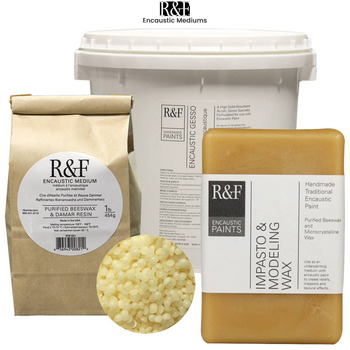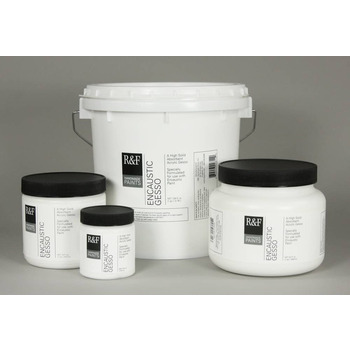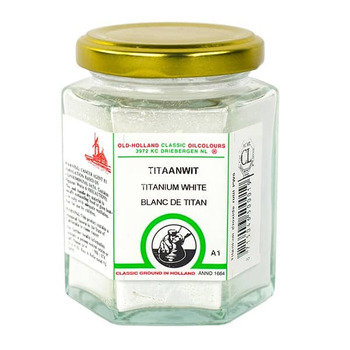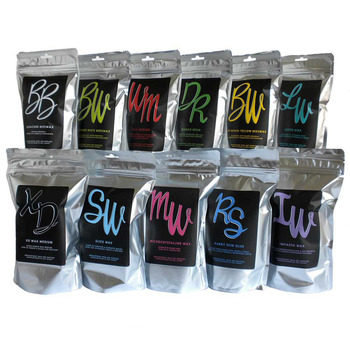Your Cart
SLI Search Template
Related Categories: Beeswax Medium | Beeswax | Resin Paints | Encaustic Wax Medium | R | Encaustic Wax | Encaustic Supplies | Wax
-
 R&F Encaustic MediumsSave Up to20%Off list…with beeswax, damar resin creates an encaustic binder that is stronger and more durable than beeswax alone, and also serves to raise the melting point of the wax. Damar is also used to create traditional oil painting mediums and varnishes. * White Beeswax (Pellets) - This natural beeswax has been… Fine handmade mediums for encaustic painting! The ancient art of encaustic painting is brought into the 21st century with this excellent collection of handmade encaustic grounds, mediums, and raw materials from R&F! Enhance your encaustic paintings or make your own mediums to your specifications with this selection of fantastic ingredients. * Encaustic Gesso - This water-based ground is a modern version of the traditional gesso mix of rabbit skin glue and chalk. Specially formulated for encaustic painting, with a lower proportion of acrylic binder to solids, making it a more absorbent and receptive surface for wax-based paints. A quick and easy brushable white gesso. Specially formulated white ground for encaustics. * Encaustic Medium - Perhaps the most essential encaustic supply, Encaustic Medium is a blend of beeswax and damar resin, and is used to increase transparency and extend encaustic paints. It is important to use Encaustic Medium with your paints, as using only beeswax will reduce stability and produce a bloom on the painting that is only removable with heat. Available in either block or pellet form. Increases transparency and extends encaustic paints. * Impasto Modeling Wax - This heavy body wax medium is made from a mix of microcrystalline wax and beeswax. It is excellent for thick structural application, casting, carving, layering, and modeling. As Impasto Wax has a higher melting point than Encaustic Medium, you can apply standard encaustics over it without easily blunting sculptural shapes. Use for thick encaustic paint application and sculptural styles. * Damar Resin Crystals - A hard, clear resin from deciduous trees, Damar Resin Crystals are used to create encaustic mediums and paints. When mixed with beeswax, damar resin creates an encaustic binder that is stronger and more durable than beeswax alone, and also serves to raise the melting point of the wax. Damar is also used to create traditional oil painting mediums and varnishes. * White Beeswax (Pellets) - This natural beeswax has been whitened by mechanical filtration, instead of standard chemical bleaching, which can lead to negative pigment reactions and break wax down. Use White Beeswax as an ingredient in creating encaustic mediums and paints, along with Damar Resin, or as an initial priming layer for paper or board. Note that beeswax used alone in encaustics (without damar) is not as stable and is apt to bloom (become foggy). Use with damar resin to create encaustic paints and mediums. * Soy Wax (Pellets) - Made from partially hydrogenated soybean oil, Soy Wax is an environmentally friendly choice for cleaning encaustic brushes and tools. Unlike paraffin wax, which is made from petroleum products, Soy Wax is non-toxic, biodegradable, and made from an easily renewable resource. Use melted Soy Wax to remove color from painting materials, then wash tools or brushes in soapy water. Eco-friendly cleaning wax. See More
R&F Encaustic MediumsSave Up to20%Off list…with beeswax, damar resin creates an encaustic binder that is stronger and more durable than beeswax alone, and also serves to raise the melting point of the wax. Damar is also used to create traditional oil painting mediums and varnishes. * White Beeswax (Pellets) - This natural beeswax has been… Fine handmade mediums for encaustic painting! The ancient art of encaustic painting is brought into the 21st century with this excellent collection of handmade encaustic grounds, mediums, and raw materials from R&F! Enhance your encaustic paintings or make your own mediums to your specifications with this selection of fantastic ingredients. * Encaustic Gesso - This water-based ground is a modern version of the traditional gesso mix of rabbit skin glue and chalk. Specially formulated for encaustic painting, with a lower proportion of acrylic binder to solids, making it a more absorbent and receptive surface for wax-based paints. A quick and easy brushable white gesso. Specially formulated white ground for encaustics. * Encaustic Medium - Perhaps the most essential encaustic supply, Encaustic Medium is a blend of beeswax and damar resin, and is used to increase transparency and extend encaustic paints. It is important to use Encaustic Medium with your paints, as using only beeswax will reduce stability and produce a bloom on the painting that is only removable with heat. Available in either block or pellet form. Increases transparency and extends encaustic paints. * Impasto Modeling Wax - This heavy body wax medium is made from a mix of microcrystalline wax and beeswax. It is excellent for thick structural application, casting, carving, layering, and modeling. As Impasto Wax has a higher melting point than Encaustic Medium, you can apply standard encaustics over it without easily blunting sculptural shapes. Use for thick encaustic paint application and sculptural styles. * Damar Resin Crystals - A hard, clear resin from deciduous trees, Damar Resin Crystals are used to create encaustic mediums and paints. When mixed with beeswax, damar resin creates an encaustic binder that is stronger and more durable than beeswax alone, and also serves to raise the melting point of the wax. Damar is also used to create traditional oil painting mediums and varnishes. * White Beeswax (Pellets) - This natural beeswax has been whitened by mechanical filtration, instead of standard chemical bleaching, which can lead to negative pigment reactions and break wax down. Use White Beeswax as an ingredient in creating encaustic mediums and paints, along with Damar Resin, or as an initial priming layer for paper or board. Note that beeswax used alone in encaustics (without damar) is not as stable and is apt to bloom (become foggy). Use with damar resin to create encaustic paints and mediums. * Soy Wax (Pellets) - Made from partially hydrogenated soybean oil, Soy Wax is an environmentally friendly choice for cleaning encaustic brushes and tools. Unlike paraffin wax, which is made from petroleum products, Soy Wax is non-toxic, biodegradable, and made from an easily renewable resource. Use melted Soy Wax to remove color from painting materials, then wash tools or brushes in soapy water. Eco-friendly cleaning wax. See More -
 R&F Encaustic Grounds, Mediums, and Raw MaterialsSave Up to20%Off list…formulated white ground for encaustics. Encaustic Medium - Increases transparency and extends encaustic paints. Impasto Modeling Wax - Use for thick encaustic paint application and sculptural styles. Damar Resin Crystals - Ingredient in making encaustic paints and mediums. White Beeswax (Pellets) -… Fine handmade mediums for encaustic painting! The ancient art of encaustic painting is brought into the 21st century with this excellent collection of handmade encaustic grounds, mediums, and raw materials from R&F! Enhance your encaustic paintings or make your own mediums to your specifications with this selection of fantastic ingredients. Encaustic Gesso - Specially formulated white ground for encaustics. Encaustic Gesso - Specially formulated white ground for encaustics. Encaustic Medium - Increases transparency and extends encaustic paints. Impasto Modeling Wax - Use for thick encaustic paint application and sculptural styles. Damar Resin Crystals - Ingredient in making encaustic paints and mediums. White Beeswax (Pellets) - Use with damar resin to create encaustic paints and mediums. Soy Wax (Pellets) - Eco-friendly cleaning wax. See More
R&F Encaustic Grounds, Mediums, and Raw MaterialsSave Up to20%Off list…formulated white ground for encaustics. Encaustic Medium - Increases transparency and extends encaustic paints. Impasto Modeling Wax - Use for thick encaustic paint application and sculptural styles. Damar Resin Crystals - Ingredient in making encaustic paints and mediums. White Beeswax (Pellets) -… Fine handmade mediums for encaustic painting! The ancient art of encaustic painting is brought into the 21st century with this excellent collection of handmade encaustic grounds, mediums, and raw materials from R&F! Enhance your encaustic paintings or make your own mediums to your specifications with this selection of fantastic ingredients. Encaustic Gesso - Specially formulated white ground for encaustics. Encaustic Gesso - Specially formulated white ground for encaustics. Encaustic Medium - Increases transparency and extends encaustic paints. Impasto Modeling Wax - Use for thick encaustic paint application and sculptural styles. Damar Resin Crystals - Ingredient in making encaustic paints and mediums. White Beeswax (Pellets) - Use with damar resin to create encaustic paints and mediums. Soy Wax (Pellets) - Eco-friendly cleaning wax. See More -

 Old Holland Classic Pigment Titanium White 110gSave Up to25%Off listWhite Prepare custom paints and base liquids with these pure, light-fast pigments and high quality raw materials! For the artists who prefer to create their own paints, Old Holland Classic Pigments and Raw Materials offers a carefully selected range of 98 light-fast dry pigments. Old Hollands organic, anorganic and synthetic organic pigments have outstanding color strength, clarity and intensity. Six different raw materials, from dammar resin to hide glue, allow artists and restorers to create their own base liquids. Old Holland uses these pigments to make all its paints. The pigments have an outstanding colour strength, clarity and brilliance Key Features: * Wide range of light-fast pure pigments * 98 light-fast dry pigments * Excellent color strength, clarity and brilliance * Organic pigments include Carmine, Indian Yellow and Madder Lacquer * Anorganic pigments include Umbers, Cadmiums and mineral pigments Perfect For: * Artists who prefer to create their own paints * Artists working in oils * Restoration work * Painting on canvas pigments can be divided into three groups: Group 1: Organic pigments Of natural origin, animal or vegetable (living), usually carbon compounds. Some examples: Carmine (from the Cochineal insect), Gummigutta, Gamboge (from the gum resin of the Garcinia Tree), Indian Yellow (from the urine of cows that eat mango leaves), Mummy (from the remains of Egyptian mummies), Madder Lacquer (from the root of the common Madder plant). Group 2: Anorganic pigments: Chemical compounds from chemical elements other than carbons (non-living). Some examples divided into three subgroups:Earth pigments: Ochres, Umbers, Green Earth, Caput Mortuum, Venetian Red. Mineral pigments: Malachite, Vermillion, Lapis Lazuli. Synthetic inorganic pigments (do not occur in nature but are manufactured): Prussian Blue, Ceruleum Blue, Lead White, Cadmiums. Group 3: Synthetic organic pigmentsComplex carbon compounds which do not occur in nature, but are created in the laboratory. Some examples: Phtalocyanine Blues and Greens, Quinacridones, Isoindolinones, Dioxazine, Azo Pigments. See More
Old Holland Classic Pigment Titanium White 110gSave Up to25%Off listWhite Prepare custom paints and base liquids with these pure, light-fast pigments and high quality raw materials! For the artists who prefer to create their own paints, Old Holland Classic Pigments and Raw Materials offers a carefully selected range of 98 light-fast dry pigments. Old Hollands organic, anorganic and synthetic organic pigments have outstanding color strength, clarity and intensity. Six different raw materials, from dammar resin to hide glue, allow artists and restorers to create their own base liquids. Old Holland uses these pigments to make all its paints. The pigments have an outstanding colour strength, clarity and brilliance Key Features: * Wide range of light-fast pure pigments * 98 light-fast dry pigments * Excellent color strength, clarity and brilliance * Organic pigments include Carmine, Indian Yellow and Madder Lacquer * Anorganic pigments include Umbers, Cadmiums and mineral pigments Perfect For: * Artists who prefer to create their own paints * Artists working in oils * Restoration work * Painting on canvas pigments can be divided into three groups: Group 1: Organic pigments Of natural origin, animal or vegetable (living), usually carbon compounds. Some examples: Carmine (from the Cochineal insect), Gummigutta, Gamboge (from the gum resin of the Garcinia Tree), Indian Yellow (from the urine of cows that eat mango leaves), Mummy (from the remains of Egyptian mummies), Madder Lacquer (from the root of the common Madder plant). Group 2: Anorganic pigments: Chemical compounds from chemical elements other than carbons (non-living). Some examples divided into three subgroups:Earth pigments: Ochres, Umbers, Green Earth, Caput Mortuum, Venetian Red. Mineral pigments: Malachite, Vermillion, Lapis Lazuli. Synthetic inorganic pigments (do not occur in nature but are manufactured): Prussian Blue, Ceruleum Blue, Lead White, Cadmiums. Group 3: Synthetic organic pigmentsComplex carbon compounds which do not occur in nature, but are created in the laboratory. Some examples: Phtalocyanine Blues and Greens, Quinacridones, Isoindolinones, Dioxazine, Azo Pigments. See More -
 Enkaustikos Encaustic MediumsSave Up to20%Off list…complement their extensive line of encaustic paints. Bleached Beeswax – Purified beeswax featuring a chemically-achieved bright white color Carnauba Wax – A Pale yellow wax used to raise the melting point of encaustics or beeswax, creating more durable paint Damar Resin – Increases… A variety of mediums and sundries for your encaustic painting applications! Enkaustikos offers a variety of wax mediums and encaustic sundries to complement their extensive line of encaustic paints. Bleached Beeswax – Purified beeswax featuring a chemically-achieved bright white color Carnauba Wax – A Pale yellow wax used to raise the melting point of encaustics or beeswax, creating more durable paint Damar Resin – Increases the shine, hardness, translucency and melting point of beeswax Impasto Wax – Builds texture and dimension when used with encaustics to produce sculptural effects Luster Wax – This white, translucent synthetic wax can be used with encaustic paint or beeswax to add shine or hardness and to increase the melting point Microcrystaline Wax – Produces a more flexible encaustic paint—ideal for building layers and texture Rabbit Skin Glue – Works great as a ground for encaustic work and is used to make a traditional gesso Slick Wax – A solvent-free blend of synthetic waxes used for cleaning brushes, tools and palettes Soy Wax – An environmentally-friendly alternative wax for cleaning brushes, tools and palettes USP Refined White Beeswax – Purified, USP-grade beeswax—free of additives or bleaching agents USP Refined Yellow Beeswax – Purified, USP-grade yellow beeswax—free of additives or bleaching agents Wax Medium – Perfect for use as a base coat, topcoat, glaze medium or extender. Made from a blend of USP white beeswax and dakar resin. Also available in natural yellow. XD Wax Medium – The addition of extra damar resin makes this medium provide a harder, shiny and transparent finish—making it ideal for glazes, topcoats and as a paint extender See More
Enkaustikos Encaustic MediumsSave Up to20%Off list…complement their extensive line of encaustic paints. Bleached Beeswax – Purified beeswax featuring a chemically-achieved bright white color Carnauba Wax – A Pale yellow wax used to raise the melting point of encaustics or beeswax, creating more durable paint Damar Resin – Increases… A variety of mediums and sundries for your encaustic painting applications! Enkaustikos offers a variety of wax mediums and encaustic sundries to complement their extensive line of encaustic paints. Bleached Beeswax – Purified beeswax featuring a chemically-achieved bright white color Carnauba Wax – A Pale yellow wax used to raise the melting point of encaustics or beeswax, creating more durable paint Damar Resin – Increases the shine, hardness, translucency and melting point of beeswax Impasto Wax – Builds texture and dimension when used with encaustics to produce sculptural effects Luster Wax – This white, translucent synthetic wax can be used with encaustic paint or beeswax to add shine or hardness and to increase the melting point Microcrystaline Wax – Produces a more flexible encaustic paint—ideal for building layers and texture Rabbit Skin Glue – Works great as a ground for encaustic work and is used to make a traditional gesso Slick Wax – A solvent-free blend of synthetic waxes used for cleaning brushes, tools and palettes Soy Wax – An environmentally-friendly alternative wax for cleaning brushes, tools and palettes USP Refined White Beeswax – Purified, USP-grade beeswax—free of additives or bleaching agents USP Refined Yellow Beeswax – Purified, USP-grade yellow beeswax—free of additives or bleaching agents Wax Medium – Perfect for use as a base coat, topcoat, glaze medium or extender. Made from a blend of USP white beeswax and dakar resin. Also available in natural yellow. XD Wax Medium – The addition of extra damar resin makes this medium provide a harder, shiny and transparent finish—making it ideal for glazes, topcoats and as a paint extender See More
Powered by












Login and Registration Form
Customer Login
Already a customer ? Sign in now for the best experience!
* indicates a required field